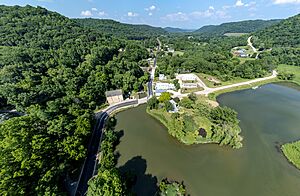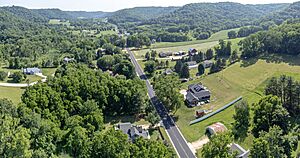Pickwick, Minnesota facts for kids
Quick facts for kids
Pickwick
|
|
|---|---|

Pickwick, with the 1850s Pickwick Mill and millpond
|
|
| Country | United States |
| State | Minnesota |
| County | Winona County |
| Township | Homer Township |
| Area | |
| • Total | 0.64 sq mi (1.66 km2) |
| • Land | 0.64 sq mi (1.66 km2) |
| • Water | 0.00 sq mi (0.00 km2) |
| Elevation | 702 ft (214 m) |
| Population
(2020)
|
|
| • Total | 157 |
| • Density | 244.55/sq mi (94.45/km2) |
| Time zone | UTC-6 (Central (CST)) |
| • Summer (DST) | UTC-5 (CDT) |
| ZIP code |
55987
|
| Area code(s) | 507 |
| GNIS feature ID | 2806366 |
Pickwick is a small, unincorporated community located in Homer Township, Winona County, Minnesota, United States. It's a quiet place known for its historic mill, the Pickwick Mill, which was built way back in the 1850s.
Contents
Where is Pickwick?
Pickwick is found in Winona County, Minnesota. It's located near Winona County Road 7, close to where it meets Little Trout Valley Road. Main highways like U.S. Route 61 and U.S. Route 14 are also nearby. Two important creeks, Big Trout Creek and Little Trout Creek, meet right near Pickwick. Other towns close by include Winona, Homer, and Dakota.
How Many People Live Here?
According to the 2020 United States Census, about 157 people live in Pickwick.
| Historical population | |||
|---|---|---|---|
| Census | Pop. | %± | |
| 2020 | 157 | — | |
| U.S. Decennial Census | |||
Pickwick's Early History
Pickwick has a long history, starting in the mid-1800s. In 1854, a man named G. W. T. Grant had a claim to the land where the famous Pickwick Mill now stands. His family lived in a cabin owned by someone else nearby.
The Rutherford and Grant Families Arrive
In June 1854, Jason E. Rutherford and his family traveled all the way from Ohio in a covered wagon. They camped at the spot that would later become Pickwick. The next day, they met up with the Grant family.
The Rutherford and Grant families then went further up Pickwick Valley. The Rutherfords decided to claim land there. They started cutting down trees to build a cabin. This cabin was the very first building in the valley. The Rutherford family lived in their covered wagon for six weeks until the cabin was finished. Then, the Grant family moved in with them! Imagine 14 people living in one small log cabin for the summer.
Later that summer, the Grants built their own cabin and moved into it. In September, the Grants and Rutherfords traveled to Iowa.
More Settlers Come to Pickwick
On April 25, 1855, the Rutherfords and Grants returned to Pickwick. This time, they brought even more families with them. These families also had covered wagons and livestock like hogs and cattle. Some of these new families decided to settle in a nearby area called Pleasant Hill.
The Famous Pickwick Mill
G. W. T. Grant built another cabin across from where the Pickwick Mill is today. He also built a dam, first out of dirt or clay, but it washed away that winter. So, Grant rebuilt the dam using strong wooden supports. This new dam could handle the powerful water. He also added a saw mill to cut wood and special grinding stones to make flour.
This project kept growing until 1858. That's when the large stone building that we know as the Pickwick Mill was finally finished. Soon after, Grant sold his share of the mill to Wilson Davis. Wilson Davis also built a small store and continued to run the mill.
The Pickwick Mill, built in the 1850s, is now listed on the National Register of Historic Places. This means it's a very important historical site. Today, it operates as a museum, where you can learn all about its past!
Growing Pickwick Village
Pickwick was officially planned out in 1857. Cynthia Grant, G. W. T. Grant's wife, gave the town its name. She named it after The Pickwick Papers, a famous novel by the author Charles Dickens.
As the mill grew, so did Pickwick. By 1858, the town had the small store, a blacksmith shop, and a wagon shop. A small building owned by the mill was used as a school. Charles Sufferins ran the post office. In 1861, he became the official postmaster and bought a share in the local store. A new school building was built by the community around 1861 or 1863.
Pickwick During the Civil War
During the American Civil War, the Pickwick Mill became very busy. It ran constantly, making about 100 barrels of flour every day for the Union Army. This shows how important the mill was to the area and even to the country during that time.
Community Gatherings
On November 11, 1873, a group called the Freemasons started a local chapter in the upstairs part of Sufferins' store. They stayed there until 1919. Later, they joined with another group, the Order of the Eastern Star, and bought a building called the "Gates Store." This building is now used by the Pickwick Mill Historical Society to show visitors a film about the mill's history.





